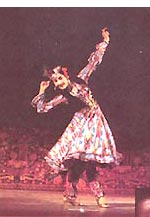|
Sama Dance
( 2005-09-13 )
 Sama, a simply group dance for New Year and other festivals, is popular mainly in Kashi and Kucha in the southern part of Northwest China's Xinjiang Uygur Autonomous Region. Sama, a simply group dance for New Year and other festivals, is popular mainly in Kashi and Kucha in the southern part of Northwest China's Xinjiang Uygur Autonomous Region.
OriginallySamawas the name of a primitive religion among ancient Uygurs. People would pray to gods of nature for hunting and harvest by singing, beating drums, and dancing at the command of the ritual leader -- the Sama. This ritual ceremony gradually turned into group entertainment for New Year and other festivals, before evolving into a solo performed on festive occasions. The dance and its musical accompaniment have been included in the third part of the Twelve Muqam.
After Islam was introduced into Xinjiang, the rulers still usedSamain their religious activities. For instance, raised hands were interpreted as "Huda god is in heaven," and a hand touching the chest, "Huda is in my heart."Suonahorns and iron drums were used for accompaniment. The whole performance was solemn and the dancers were not allowed to laugh. In a temple the dance had no musical accompaniment. The performers simply shouted, "E'wu, e'wu e'wu," rhythmically while they danced. But on ordinary occasions the performance was joyous and jubilant.
Early in the morning of the Corban Festival the clear beat of iron drums reaches faraway families. Wearing gorgeous costumes, people converge on the open square in front of a big mosque to celebrate the traditional festival. They start theSamain counterclockwise order to the accompaniment of clear and powerful melodies and the accentuated beat of the iron drums. As the tempo quickens, the sound grows louder and the dance becomes more passionate and exciting, ending jubilantly.
Samais mainly performed by men, except in a few places. The steady footwork and vigorous movements are closely coordinated with the drumbeat. At the beat of the drum the dancers stamp the ground and hold, not raising the foot immediately.
The hands are held in a natural half fist. The performer extends his fingers as he swings his arm, then clenches them again as he pulls his arm back. A common movement is a brush step followed by a spin or a step followed by a jump and turn.
Samahas its own special melodies. Familiar Muqam music or Sanam melodies are performed as prelude, before a shift in the drumbeat cues in theSamamelodies.
Samarhythms are strong and vigorous. The main instruments are suona horns and iron drums. Drums with different tones form a group, producing a striking tonal effect. The melodies played by the suona horns are quite flexible and not restricted by the drumbeat.
|

